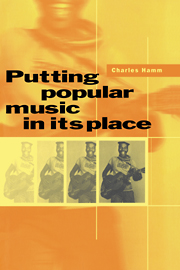Book contents
- Frontmatter
- Contents
- Acknowledgements
- Preface
- 1 Modernist narratives and popular music
- 2 Rock and the facts of life
- 3 Changing patterns in society and music: the US since World War II
- 4 “If I Were a Voice”: or, The Hutchinson Family and popular song as political and social protest
- 5 Some thoughts on the measurement of popularity in music
- 6 Elvis, a review
- 7 Home cooking and American soul in black South African popular music
- 8 Rock ‘n’ roll in a very strange society
- 9 African-American music, South Africa, and apartheid
- 10 “The constant companion of man”: Separate Development, Radio Bantu, and music
- 11 Privileging the moment of reception: music and radio in South Africa
- 12 Music and radio in the People's Republic of China
- 13 Towards a new reading of Gershwin
- 14 A blues for the ages
- 15 Graceland revisited
- 16 Dvořák in America: nationalism, racism, and national race
- 17 The last minstrel show?
- 18 The Role of Rock, a review
- 19 Genre, performance, and ideology in the early songs of Irving Berlin
- 20 Epilogue: John Cage revisited
- Index
19 - Genre, performance, and ideology in the early songs of Irving Berlin
Published online by Cambridge University Press: 05 February 2012
- Frontmatter
- Contents
- Acknowledgements
- Preface
- 1 Modernist narratives and popular music
- 2 Rock and the facts of life
- 3 Changing patterns in society and music: the US since World War II
- 4 “If I Were a Voice”: or, The Hutchinson Family and popular song as political and social protest
- 5 Some thoughts on the measurement of popularity in music
- 6 Elvis, a review
- 7 Home cooking and American soul in black South African popular music
- 8 Rock ‘n’ roll in a very strange society
- 9 African-American music, South Africa, and apartheid
- 10 “The constant companion of man”: Separate Development, Radio Bantu, and music
- 11 Privileging the moment of reception: music and radio in South Africa
- 12 Music and radio in the People's Republic of China
- 13 Towards a new reading of Gershwin
- 14 A blues for the ages
- 15 Graceland revisited
- 16 Dvořák in America: nationalism, racism, and national race
- 17 The last minstrel show?
- 18 The Role of Rock, a review
- 19 Genre, performance, and ideology in the early songs of Irving Berlin
- 20 Epilogue: John Cage revisited
- Index
Summary
This paper was read on 5 November 1993 at the annual meeting of the American Musicological Society in Montreal. It seemed to me, at the moment, that I had articulated in the simplest possible terms the concept I'd been struggling towards for many years: that the meaning of a piece of popular music is shaped most importantly at the moment of performance; that this meaning can change from performance to performance; therefore one must either be present at a given performance, or reconstruct it, in order to understand this meaning.
Irving Berlin's 200-odd songs written between 1907, the date of the first one, and late 1914, when his first complete show for the musical stage (“Watch Your Step”) opened at New York's Globe Theatre, are virtually identical to one another in their published piano–vocal format. Like other Tin Pan Alley songs of the early twentieth century, most of them consist of a brief piano introduction, a few bars of vamp, then several verses, each followed by a chorus. All are in major keys and most have a tempo marking of Moderato. Piano introductions are drawn from either the first or last phrase of the chorus, the vamp anticipates the melodic beginnings of the verse, and both verse and chorus are usually made up of four 4-bar phrases in C or four 8-bar phrases in other meters.
- Type
- Chapter
- Information
- Putting Popular Music in its Place , pp. 370 - 380Publisher: Cambridge University PressPrint publication year: 1995



